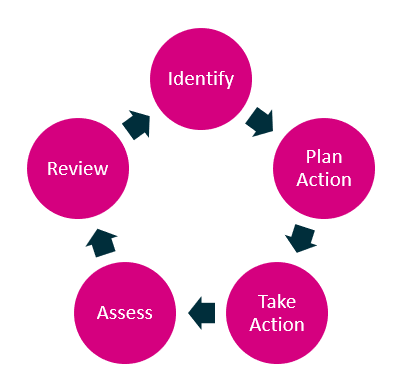A trainees’ learning to teach is complex and involves many aspects of practice developing at the same time. It is therefore impractical to document everything they do in order to progress. So, each week, the Focus Improvement Area identifies an important aspect of practice that needs addressing and is the one that is formally documented in the trainee’s ePortfolio.
The progress in the Focus Improvement Area must not come at the expense of progress in the other aspects of practice that also need addressing. Targets and action plans for these will need to be set and documented accordingly at the same time. The Focus Improvement Area though will feature more heavily in the trainee’s weekly reflection and form the agreed focus of the formal lesson observation.
The Focus Improvement Area therefore is an important area of practice. Its development is key and worthy of clearly documenting to show progress. It is identified through the following cycle:

- Plan action: Through discussion, trainees and CMs set target(s) and construct appropriate action plans to address the issue.
- Take action: During the week, trainees work through the action planning to achieve the target(s).
- Assess: The following formal lesson observation provides evidence of meeting the target(s) as the Focus Improvement Area is the lesson’s agreed focus.
- Review: The following weekly reflection considers the impact on children’s learning and progress and the trainee’s own learning to teach.
Using the Focus Improvement Area to integrating theory & practice
The following procedures are designed to help CMs and trainees find ways in which trainees can readily integrate theory with their practice as they develop their own theory with a small ‘t’.
- Prior to teaching a topic, trainees are encouraged to refer to any notes they took during the corresponding University session, the seminar slides that accompanied it and any additional readings relating to it. In recapping these materials a focus should be identified. For example, in mathematics and the development of written calculation skills in multiplication, the focus might be upon the use of the array in supporting children’s conceptual understanding of the grid method.
- CMs and trainees are encouraged to discuss the focus at a weekly review or weekly discussion meeting before teaching takes place so that they are clear on what the theory says. The CM should then observe a lesson in connection with the focus and noting it in the “agreed lesson observation focus” box at the top of the lesson observation form. Feedback should be steered towards, but not exclusive to, the focus.
- Discussions at the following weekly review or weekly discussion could include:
- the things that went well and those that didn’t;
- which aspects of the children’s learning were (and weren’t) expected or anticipated according to the theory;
- events that occurred during the lesson that clearly illustrate the theory.
We would also encourage trainees to continually have in place a target that relates to theory and practice. Once one is achieved another could be set in a different curriculum subject.
CMs can become familiar with the content of university sessions by asking their trainees about them, what they learned and reflected on, what they found interesting and what they have used in practice. Trainees are also encouraged to share their notes with CMs in supporting these discussions.
